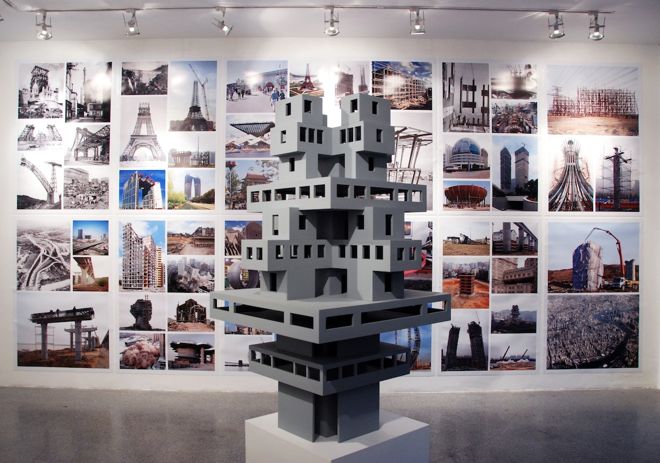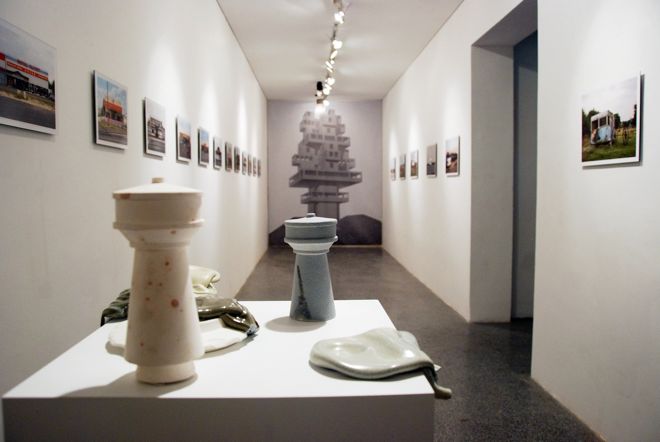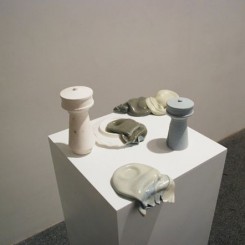“Monument to Progress,” solo exhibition by Eric Tabuchi.
HKU/ Shanghai Study Centre (298 Suzhou Bei Lu, Shanghai, China). May 18, 2013 – Aug 18, 2013.
Monumental architecture is simple. Its strict geometries of circles, squares and triangles; its complex arches or layers; or its great mass or height simply demand attention. But can a renowned building lose its esteemed position? And can the commonplace gain monumental status? The monumental and anti-monumental trade punches in “Monument to Progress” at the HKU/ Shanghai Study Centre. Parisian photographer Eric Tabuchi’s engaging mix of work — including his own photographs, found photographs and scale models — calls for a reconsideration of the concept of monumentality.
The first room of the exhibition presents found photographs of the construction, realization and occasional destruction of prominent buildings. Here “monument” means “look at me,” and it is easy to get caught up in both the wonderful and the wacky architecture that covers the globe. The internet that Tabuchi uses as source material could offer monumental overload, but his curatorial eye is strong and his way of displaying formal proximities between buildings is delightful.

Exhibition view of Eric Tabuchi’s “Monument to Progress” at HKU/ Study Center
Eric Tabuchi《前进的丰碑》的展览现场,香港大学上海学习中心。
One wall features a black and white collage of recognizable monuments: Paris’s Grande Arche, Beijing’s CCTV Headquarters, New York’s World Trade Center, Suzhou’s “Long Underpants” Gate of the Orient, and the like. Careful viewers will spot both the original Eiffel Tower and its reproduction in Hangzhou. The mash of buildings, each vying for position in a wallpaper of images, diminishes the significance of individual photos. An adjacent wall contains a single shelf supporting five tablet computers; each holds image after image of mostly anonymous buildings. As a group, they produce a sense of Soviet-era monumentality, with over-the-top designs struggling to make a name for themselves, their town, or their country. Here, monumentalism feels like desperation — a not unfamiliar motive for erecting monuments.
The second room of “Monument to Progress” includes Tabuchi’s own photographs. Facing walls hold two series shot in the outskirts of Paris, Small Town Chinese Restaurants and Mobile Homes. The former could easily be mistaken for restaurants in New Jersey strip malls were it not for signs announcing “Dragon D’Or” and “Le Shanghai.” The buildings’ bright red and yellow texts suggest that a sunny experience awaits within, but the expanse of asphalt in the foreground of each photo is more foreboding. The latter series shows seemingly uninhabited mobile homes standing alone on a roadside, parking lot, or patch of grass. Shuttered windows and peeling aluminum siding emphasize the stereotypical desolation of this building type.
The dull, low-lying, horizontal buildings in both “Small Town Chinese Restaurants” and “Mobile Homes” should evoke the everyday. But instead the room projects a kind of monumentality. The mere act of shooting these banal buildings brings them out of obscurity. Framing a single building in the center of each photo offers it prominence. And the richly colored prints, mounted and hung just so, give the buildings much more prestige than the collaged or computer-displayed monuments in the adjacent room.
Most significantly, by shooting a series of a building type, that type is instantly elevated. Tabuchi understands the precedence for this. He re-created Ed Ruscha’s 1963 series Twenty-Six Gasoline Stations, a project he calls “a perfect illustration of the distancing of photography.”(1) He cites Bernd and Hilla Becher and Lewis Baltz as influences. (2) Consider their German water towers and American industrial parks, and Tabuchi’s French Chinese restaurants and motor homes make sense. In what may be a nod to the Bechers, “Monument to Progress” exhibits five small ceramic water towers (three of which are flaccid) produced in Shanghai from Tabuchi’s drawings of French water towers.

Exhibition view of Eric Tabuchi’s “Monument to Progress” at HKU/ Study Center
Eric Tabuchi《前进的丰碑》的展览现场,香港大学上海学习中心。
A series-less series rounds out the exhibition and gives it its name. “The Monument to Progress,” an oddly shaped tower in Chongqing, appears and reappears in the two rooms. Photography buffs may recognize the unique building from Nadav Kander’s Yangtze, The Long River series. Tabuchi used other found photographs of the building as his source. One photo is used for the exhibition poster. Another is reproduced in the collage of monuments. A model of the building made of medium-density fiberboard takes up the central space in one room, while a photo of a digital model of it covers a wall in the other.
The multimedia representations of the Chongqing tower allow visitors to consider how monuments are reproduced. The terrible truth of architecture is that more people know famous buildings from drawings, models, and photographs than from walking inside them. But this tower’s participation in a series — its pure and simple repetition — allows for another reading. Repetition can transport a nursery rhyme or an advertising jingle from the realm of simplicity into that of grandeur. The same might be true for a building. The actual “Monument to Progress,” now demolished, may have been monumental in name only. But see representations of it often enough, and the odd structure starts to look like a right and proper monument. It is a testament to the building — or more likely to Tabuchi’s use of it — that a seemingly undeserving structure makes us rethink our conception of monumentality.
(1) Eric Tabuchi, “Q/A,” Eric Tabuchi, http://erictabuchi.fr/index.php?/images-2009/links/ (accessed May 20, 2013).
(2) Ibid.

